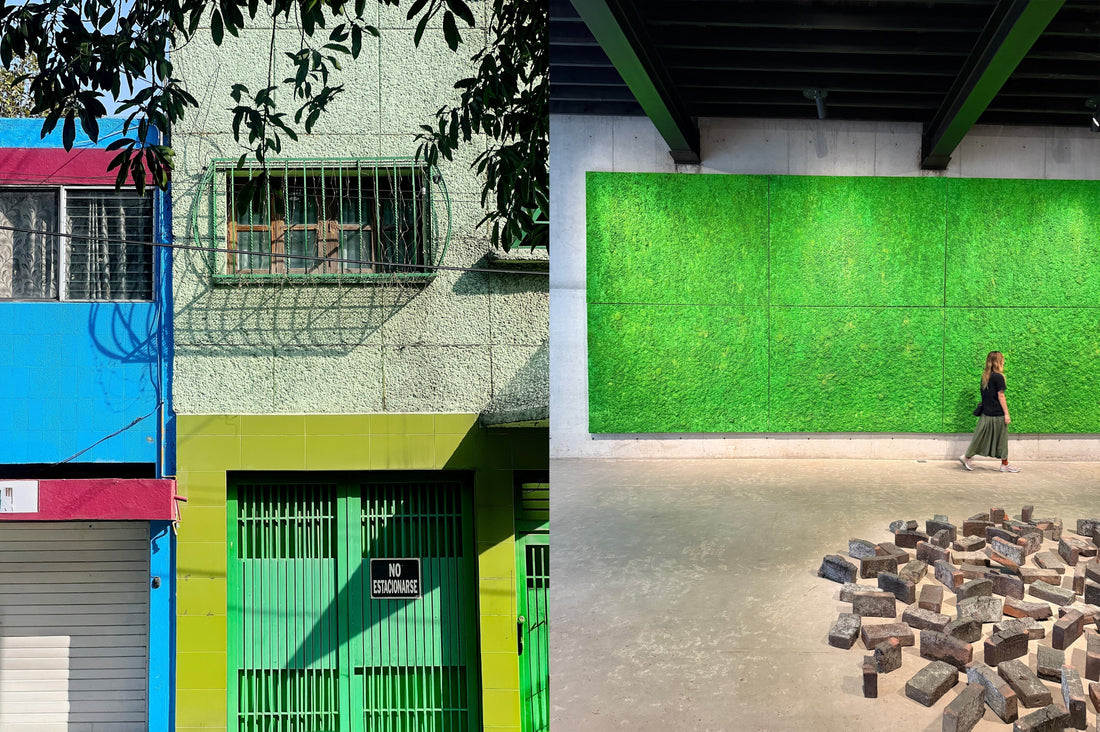
O-M Journeys: Mexico City: Color, Memory, and Quiet Moment
Share
I’ve found myself returning to Mexico City again and again since the pandemic. Each visit feels familiar, but never the same—there’s always another layer to notice, another rhythm to fall into. This time, the city revealed itself once more, textured and alive.

It was August, the rainy season. Most afternoons, clouds gathered and the sky opened for an hour or two. The sound of rain felt soothing, a soft interruption to the day. Afterward, the city smelled fresh—the air cooled, the colors deepened, everything seemed rinsed and alive again.
I didn’t set a strict plan for this trip. What I wanted most was time—to wander, to explore, to go slow. The only things I marked ahead were a visit to Casa Wabi, an art foundation where architecture becomes its own form of reflection, and a dinner at Rosetta, a ritual of its own.

Artwork : artist Bosco Sodi at Casa Wabi
We almost always stay in Roma Norte, but this time we tried a different hotel, where the stairway opened to the sky. I kept returning to that view—walls of an old structure framing light and air, history and present connected by a single line. When it rained, the sound carried down through the open ceiling, soft and steady, filling the building with its rhythm. Afterward, the city felt newly washed—green brighter, stone darker, the air fresh with the scent of rain. Just a few streets away, in Plaza Río de Janeiro, the same rhythm continued. The canopy of trees softened the noise of the city; dogs circled each other on the grass, neighbors paused mid-walk to talk—everything moving with a quiet, unspoken tempo.

We began to move through the city at our own pace, drawn by small details and familiar streets. At Gala Panadería, the scent of butter and flour filled the air, trays sliding in and out of the oven, the quiet choreography of hands at work. Sitting almost in the middle of the kitchen felt grounding—like watching craft unfold in real time.

At La Laguna S.A. de C.V., the energy shifted—modern and industrial, yet layered with warmth. The restored warehouse held a mix of design studios, furniture makers, cafés, and independent magazines, all sharing space beneath a structure of concrete and light. It felt alive with quiet creativity, a place where architecture and community met in balance.


Elsewhere, moments surfaced like small discoveries: matcha at San, the calm space of Casa Bosques, the utility of Utilitario Mexicano. At Xinu Perfumes, scent became sculpture, held in glass; at Mooni Art Gallery, color and form played together—contemporary, playful, and bright with imagination.
In between, I slipped into small boutiques—Goma, PCH, Cardón—each with its own sense of character. Their selections felt personal and expressive, curated with a distinct voice rather than scale. These spaces, like the artworks and plazas, reminded me that creativity in Mexico City moves in many forms: sometimes grand, sometimes quiet, always intimate.
Art revealed itself in contrasts. At the Museo del Palacio de Bellas Artes, scale and ornament swelled into grandeur; at Casa Wabi, silence became the architecture. I carried both with me—exuberance and restraint, gestures and stillness—much like clay carries the mark of both touch and fire.

Evenings had their own tone. Wine at Oropel, tacos at Cariñito or Maizajo, music echoing through Café de Nadie. Each moment felt less like nightlife and more like another layer of the city’s composition—textures shifting from soft to sharp, from pause to pulse.

Mexico City always lingers in my work. The tiled walls, worn facades, playful boutiques, and sudden bursts of color reminded me how surfaces hold memory, how layers of history can live together at once. In clay, I return to those ideas—the imperfect textures, the balance of quiet and exuberance, the way a single brushstroke or glaze can feel like a fragment of the city itself.
I was struck by the bold palette on many buildings — pinks, blues, ochres — like layers of memory pressed into facade. Walking Roma Norte, you see that many of its stately houses and mansions were built in the early 20th century. These historic structures carry character: their details, the cracks, the fading paint — all of it fed into how color feels alive here.

What stayed with me most was the reminder to slow down. To wander without purpose, to sit for coffee, to listen to rain move through an open stairway. Mexico City makes space for those pauses, and in them, I found a rhythm that felt essential. Time spent gently is never wasted—it gathers, like layers, until it becomes its own kind of work.
